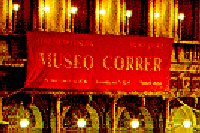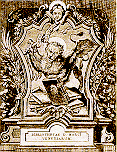Venezia - The Correr museum

The museum offers an exciting itinerary to discover the Art and the History of Venice. Born of the collection donated to the city of Venice in 1830 by Teodoro Correr, the Museum has grown through later gifts, acquisitions and donations, which constitute the rich and varied heritage of the Venetian Civic Museums.
The museum's itinerary begins with the Napoleonic Wing, in the splendid Neo-classical Rooms which became, after the fall of the Republic (1797), the Venetian Royal Palace of the French, the Asburgo, and the Kings of Italy (1866). The exposition continues in the halls of the Procuratie Nuove, designed by V.Scamozzi at the end of the XVIth century where the major Venetian magistratures were located. In the ample and austere halls are illustrated various aspects of Venetian civilisation and the collections of ancient art are displayed.

Museum of The Correr Museum is associated with: The the XVIIIth Century at Caа Rezzonico, the Gallery of Modern Art at Caа Pesaro,the Glass Museum on Murano, the Museum of Natural History, the Fortuny Museum, the Research Centre on the History of Textiles and Costume at Palazzo Mocenigo, Casa Goldoni, the Lace Museum on Burano, the Historic Archives of the City of Venice.
ITINERARIES
FIRST FLOOR. The itinerary begins with the Neo-classical Rooms of the Royal Palace, which constitute a splendid background for the collection of statues and bas-reliefs by Antonio Canova; then the Historic Collections, which reevoke, through suggestions and significant events, the great themes of the institutional history of Venice in the centuries of its greatness and political independence; commerce, navigation, political and military strength. A collection of maps and Mews illustrates the urbanistic evolution of the City. Following is the collection of Small Renaissance Bronzes from the Paduan and Venetian schools of the XVth and XVIth centuries (works by Riccio, N. Roccatagliata, G. Campagna, T. Aspetti) and the section dedicated to Arts and Crafts and to Games, both popular and noble, at the time of the Serenissima.
SECOND FLOOR. The Picture Gallery, one of the richest and most suggestive of Venetian painting from its origins to the early XVIth century, with masterpieces by Antonello da Messina, Carpaccio, the Bellini family, Cosmи Tura, Lotto. The arrangement of the exposition is by Carlo Scarpa (I960); the Ivory Collection, exquisite realisations from late-Roman, Gothic and Renaissance times; the collection of Venetian and Center-Italian Majolica of the XVth and XVIth centuries, including the famous Correr dinner-service; the Museum of the Risorgimento, with paintings, objects and documents pertinent to the events in the City from the end of the Republic through the French and Austrian domination, through the annexation to the Kingdom of Italy. Contiguous to the exhibition rooms is the Museum Library, specialised in Art and History, and the Cabinet of Prints and Drawings with graphic material of the highest level.